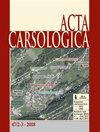印度喜马拉雅西部克什米尔山谷的喀斯特地貌、洞穴发育和水文地质
IF 1
4区 地球科学
Q4 GEOSCIENCES, MULTIDISCIPLINARY
引用次数: 10
摘要
克什米尔山谷南部的三叠纪石灰岩中发育有地表和地下岩溶特征,如karren、doline、下沉的溪流、洞穴以及大型淡水和温泉。岩层具有高导水率(K),高达1000md-1,是该地区生产力最高的含水层之一。从该含水层排出的泉水为100多万人提供了原始水源,但人们对该地区的岩溶系统仍知之甚少。本研究实际上是对一个重要但偏远且以前未经研究的地区的首次初步研究,目的是对岩溶现象进行首次概述和盘点,作为未来更详细(更“科学”)研究的基础。结果表明,卡丁作用沿构造节理和层面发育。岩溶作用随海拔高度变化明显,并向谷底方向发展。该研究还表明,冲积层沿溪流的侵蚀推动了卡丁化作用的下降,并导致以前的洞穴通道干涸。根据该地区的地貌、地质和气候条件对岩溶演化进行重建,表明岩溶作用始于上新世。目前的地表和地下成岩作用与喜马拉雅的构造沉积史和喜马拉雅造山运动后的气候条件直接相关。关键词:三叠纪石灰岩,岩溶作用,淡水供应,喜马拉雅,克什米尔山谷。克什米尔山谷、喜马拉雅山脉西部、印度的喀斯特地貌、洞穴发育和水文地质三叠纪石灰岩在克什米尔山谷南部形成了上部和地下岩溶形式,如弹片、钻孔、天坑河、洞穴以及大型淡水和温泉。这些含水层具有高达1000md-1的导水率(K),是该地区生产力最高的含水层之一。这个蓄水层的泉水为100多万人提供了清洁的水源。然而,人们对区域岩溶系统的水文地质一直知之甚少。该工作室是一个重要但偏远且以前未经勘探的地区的第一个也是初步的工作室,试图提供岩溶现象的第一个概述和清单,作为更详细(更“科学”)的工作室的基础。结果表明,装饰是沿构造断裂带和弯折带发育的。装饰根据海拔高度的不同而有所不同,并且向山谷底部更为发达。研究还表明,沿着水道的冲积侵蚀将装饰物推向含水层的深处,并导致以前脆弱的洞穴通道石化。根据该地区的地貌、地质和气候条件重建岩溶发育,表明该地区的美化始于上新世至更新世之间。目前地表和地下的点缀与喜马拉雅山脉的构造沉积史和喜马拉雅造山运动后的气候条件直接相关。关键词:三叠纪石灰岩,点缀,供水,喜马拉雅山,克什米尔山谷。本文章由计算机程序翻译,如有差异,请以英文原文为准。
Karst geomorphology, cave development and hydrogeology in the Kashmir valley, Western Himalaya, India
Surface and underground karst features, such as karren, dolines, sinking streams, caves and large freshwater and thermal springs are developed in Triassic Limestone in the southern Kashmir Valley. The rock formation has a high hydraulic conductivity (K), up to 1,000 m d-1 and constitutes one of the most productive aquifers in the region. Springs discharging from this aquifer supply pristine water to more than one million people, but the regional karst system is still poorly understood. The present study is really a first and preliminary study of an important but remote and previously unstudied area, with the goal to provide a first overview and inventory of karst phenomena, as a basis for more detailed (and more “scientific”) studies in the future. Results suggest that karstification is developed along tectonic joints and bedding planes. Karstification shows distinct variation with altitude and is more developed towards the valley floor. The study also revealed that erosion of the alluvium along streams pushed karstification downwards and caused drying up of formerly phreatic cave passages. Reconstruction of karst evolution on the basis of geomorphological, geological and climatic conditions of the region suggests that karstification has started during Plio-Pleistocene. The present surface and subsurface karstification is directly related to the tectono-sedimentational history of the Himalaya and the climatic conditions that prevailed after the Himalayan Orogeny. Key words: Triassic Limestone, karstification, freshwater supply, Himalaya, Kashmir Valley. Kraska geomorfologija, razvoj jam in hidrogeologija v Kasmirski dolini, Zahodna Himalaja, Indija Povrsinske in podzemne kraske oblike, kot so skraplje, vrtace, reke ponikalnice, jame ter veliki sladkovodni in termalni izviri, so v južni Kasmirski dolini nastale v triasnih apnencih. Ti imajo visoko hidravlicno prevodnost (K) do 1000 m d-1 in so med najbolj produktivnimi vodonosniki v regiji. Izviri, ki drenirajo ta vodonosnik, prispevajo neoporecno vodo vec kot milijon ljudem. Kljub temu hidrogeologijo regionalnega kraskega sistema se vedno slabo razumemo. Ta studija je prva in preliminarna studija pomembnega, a oddaljenega in predhodno neraziskanega obmocja ter poskusa zagotoviti prvi pregled in popis kraskih pojavov kot podlaga za podrobnejse (in bolj »znanstvene«) studije. Rezultati kažejo, da je zakrasevanje razvito vzdolž tektonskih prelomov in lezik. Zakrasevanje se razlikuje glede na nadmorsko visino in je bolj razvito proti dnu doline. Studija je pokazala tudi, da je erozija aluvija vzdolž vodotokov potisnila zakrasevanje v globino vodonosnika in povzrocila fosilizacijo predhodno freaticnih jamskih kanalov. Rekonstrukcija kraskega razvoja na podlagi geomorfoloskih, geoloskih in klimatskih razmer v regiji nakazuje, da se je zakrasevanje zacelo med Plio-Pleistocenom. Sedanje povrsinsko in podzemno zakrasevanje je neposredno povezano s tektonsko-sedimentacijsko zgodovino Himalaje in podnebnimi razmerami, ki so prevladovale po himalajski orogenezi. Kljucne besede: triasni apnenec, zakrasevanje, oskrba z vodo, Himalaja, dolina Kasmir.
求助全文
通过发布文献求助,成功后即可免费获取论文全文。
去求助
来源期刊

Acta Carsologica
地学-地球科学综合
CiteScore
1.50
自引率
14.30%
发文量
0
审稿时长
>12 weeks
期刊介绍:
Karst areas occupy 10-20 % of ice-free land. Dissolution of rock by natural waters has given rise to specific landscape and underground. Karst surface features and caves have attracted man''s curiosity since the dawn of humanity and have been a focus to scientific studies since more than half of millennia.
Acta Carsologica publishes original research papers and reviews, letters, essays and reports covering topics related to specific of karst areas. These comprise, but are not limited to karst geology, hydrology, and geomorphology, speleology, hydrogeology, biospeleology and history of karst science.
 求助内容:
求助内容: 应助结果提醒方式:
应助结果提醒方式:


